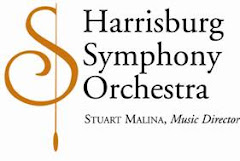 The Harrisburg Youth Symphony Orchestra will play their last Forum performance under the direction of Dr. Ronald E. Schafer tonight at 7:30 p.m. at the Forum in downtown Harrisburg.
The Harrisburg Youth Symphony Orchestra will play their last Forum performance under the direction of Dr. Ronald E. Schafer tonight at 7:30 p.m. at the Forum in downtown Harrisburg.Dr. Schafer is retiring after 42 years conducting the Youth Symphony.
And he's only the second director of the orchestra since it was founded in 1953 by Dr. Noah Klauss. Klauss taught violin and composition in the area and it is appropriate that tonight's program includes one of his compositions.
The orchestra is one of the oldest youth symphonies in the country. Its 85 musicians represent the finest from public, private, and home-school institutions in the Central Pennsylvania area.
This final performance under Dr. Schafer’s direction will include special guests, Central Dauphin CD Singers (Charles Masters, Director), Hershey High School Cantabile Choir (Joseph Farrell, Director) and Piano Soloist, Charles Masters.
The program will include:
Poet & Peasant: Overture -- Franz von Suppe
Hungarian Dance No. 1 in G minor -- Johannes Brahms
Cavalleria rusticana: Intermezzo -- Pietro Mascagni
Prelude for Orchestra -- Noah Klauss
Serenade for Strings: Finale -- Peter Ilyich Tchaikovsky
Pictures at an Exhibition: The Great Gate of Kiev -- Modeste Moussorgsky
Then joined by the choirs, the program continues with
The Creation: The Heavens are Telling -- Franz Josef Haydn
Choral Fantasy in C minor for Piano, Orchestra & Chorus -- Ludwig van Beethoven (with pianist Charles Masters, soloist)
*** ***** ******** ***** ***
Approximately one-third of HYSO graduates will continue as music majors at the college and conservatory level. Many will continue to play in college and community orchestras. Presently, Harrisburg Youth Symphony graduates are performing in the Harrisburg, Dallas, Chicago, Houston Opera, and Cincinnati Symphony Orchestras, and in regional orchestras throughout the United States.
Students participating in the HYSO represent the following schools: Annville-Cleona, Halifax, Biglerville, Harrisburg Academy, Big Spring, Hershey, Bishop McDevitt, Boiling Springs, Lower Dauphin, Carlisle, Cedar Cliff, Cedar Crest, Central Dauphin, Central Dauphin East, Covenant Christian Academy, Cumberland Valley, Elizabethtown, Mechanicsburg, Middletown, Redland, Susquehanna Township, Trinity, Upper Dauphin, West Perry, Mansfield University, and Lancaster General College.
Congratulations to this year's graduating seniors:
Kara Baker, violin, Central Dauphin East
Dominic Baldoni, Principal flute, Big Spring
Kristianne Bartolome, violin, Hershey
Emily Bayer, viola, Central Dauphin
David Bolton, viola, Cumberland Valley
Alexa Elias, oboe, Boiling Springs
Jessica Godshall, cello, Cedar Cliff
Emily Hansen, flute, Hershey
Kendall Hartman, violin, Hershey
Michele Herneisey, Principal horn, Middletown
Hanearl Kim, Principal cello, Hershey
Hilare Kimmel, violin, Cumberland Valley
Lara Miller, Principal tuba, Red Land
Kevin Myers, trombone, Bishop McDevitt
Mat Pagliassotti, violin, Central Dauphin
Angela Pornel, viola, Harrisburg Academy
Elisebeth Ross, clarinet, Red Land
Kailene Shank, viola, Elizabethtown
Mackenzie Sorem, violin, Harrisburg Academy
Chelsea Wanco, violin, Cedar Cliff
Hope Wingard, Principal trumpet, Middletown
Jessica Yeh, violin, Cumberland Valley
Dr. Schafer has spent most of his musical career teaching and conducting in the Central Pennsylvania area. He served as String Specialist and Director of Orchestras for 36 years in the Derry Township Public Schools, Hershey, and continues as Music Director of the Harrisburg Youth Symphony Orchestra, a position he has held for 38 years.
During his career Ron was invited to conduct various County, District, and Regional Orchestras in Pennsylvania , New York , and Maryland. The Pennsylvania Music Educators Association appointed him All-State Festival Chairman from 1979-1985 and in 1992 he was selected by PMEA to be guest conductor of the Pennsylvania All-State Orchestra that performed in Heinz Hall, Pittsburgh.
During his 25th Anniversary year, the Harrisburg Symphony Association presented him with their “Golden Baton” Award. The Pennsylvania and Delaware String Teachers Association recognized his career accomplishments with their “Distinguished Service Award.”
Locally, Ron also served as conductor of the Messiah College Orchestra, The Hershey Symphony Orchestra, the Central Pennsylvania Symphony Orchestra, and The Harrisburg Opera Orchestra. A teacher of violin and viola, and a former member of the Harrisburg Symphony Orchestra, he continues his support of educational and cultural activities by serving on the Education Committee of the Harrisburg Symphony Association and guest conducting and adjudicating festivals. Ron holds a Bachelors Degree from West Chester University, and a Masters and Doctorate from The Pennsylvania State University. An avid sports car enthusiast, he enjoys racing around the circuits at Watkins Glen, Pocono, and Mid-Ohio Race Tracks with other Porsche trained owners.
Tickets are not required for this concert: all seats are free.
- Kim Isenhour, Director of Marketing, Harrisburg Symphony
- Dick Strawser
















